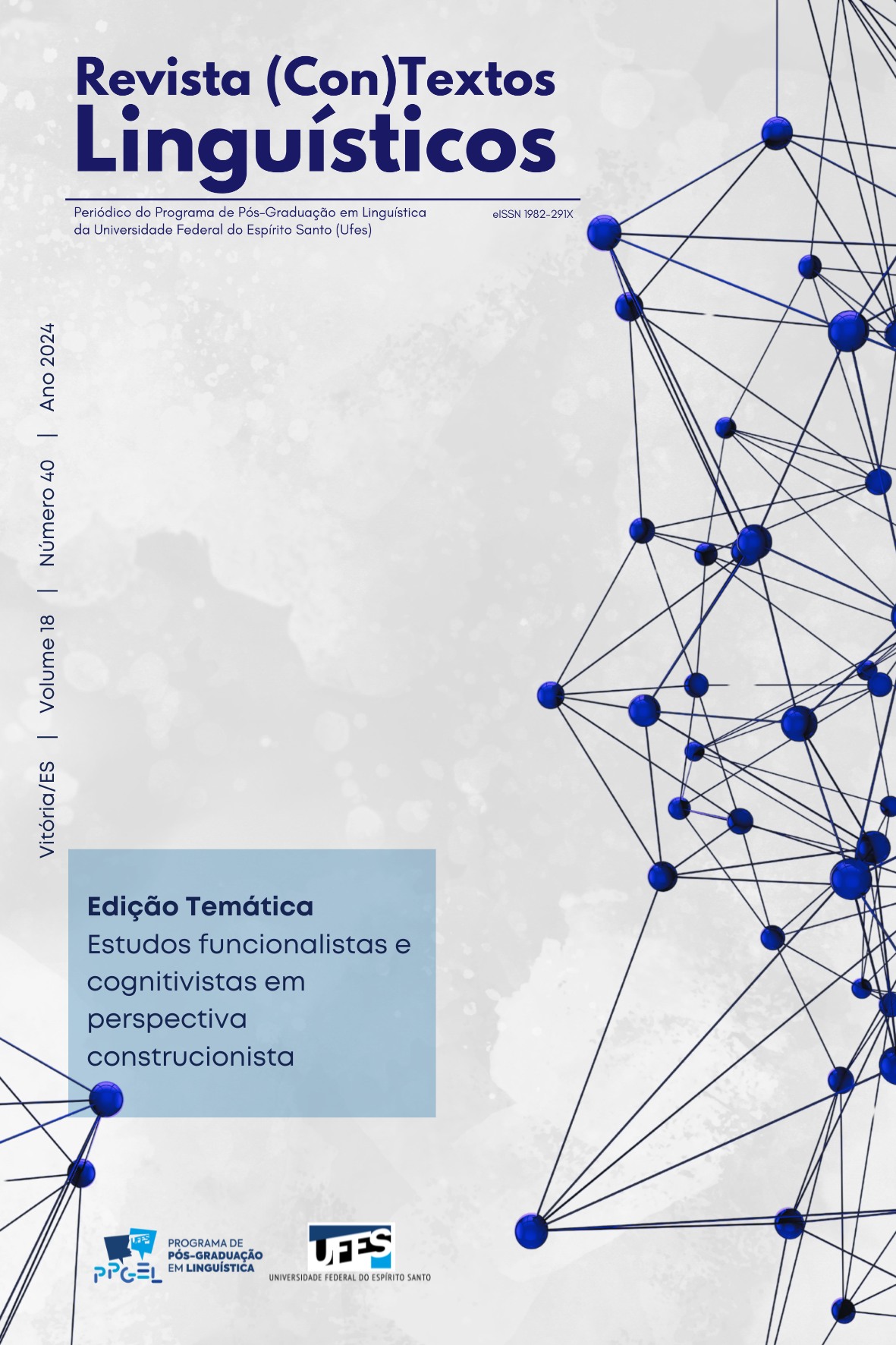Articuladores de relação lógico-semântica, discursivo-argumentativa e de organização textual
descrevendo os padrões de uso de [sendo assim], [fora que] e [(es)pera aí]
DOI:
https://doi.org/10.47456/rctl.v18i40.45229Palavras-chave:
Construção, Articuladores, Linguística Funcional Centrada no Uso, Linguística TextualResumo
Fundamentado nos pressupostos da Linguística Funcional Centrada no Uso em diálogo com a Linguística Textual, este artigo busca descrever alguns padrões funcionais de três microconstruções [sendo assim], [fora que] e [(es)pera aí], em seus usos como articulador lógico-semântico, articulador discursivo-argumentativo e articulador de organização textual, respectivamente. Tais articuladores participam tanto da articulação textual, no nível microestrutural e intermediário, quanto da promoção dos sentidos em um texto. Numa perspectiva sincrônica, tomamos como base textos escritos e escritos como reprodução de fala do Corpus do Português para a análise de nossos dados. Realizamos um estudo prioritariamente qualitativo, descrevendo não só as propriedades de forma e sentido (Croft, 2001) dessas três microconstruções mas também como, atuando como articuladores, estabelecem a conexão das porções textuais (Koch e Elias, 2016). Os resultados apontam que [sendo assim] é um conector com valor semântico de resultado, que, pragmaticamente, apresenta gradiência entre consequência e conclusão; por sua vez, [fora que], ao adicionar o argumento final de uma escala, enfatiza o conteúdo veiculado que funciona como último recurso de convencimento; por fim, [(es)pera aí], como um marcador discursivo, volta-se para a interação entre os interlocutores, auxiliando também na articulação dos enunciados do ato comunicativo.
Downloads
Referências
BEAUGRANDE, R. A. de.; DRESSLER, W. Einfhrung in die Textlinguistik. Tübingen: Niemeyer, 1981.
BYBEE J. L. Chunking and degrees of autonomy. In: Language, Usage, and Cognition. Cambridge, UK: CUP, 2010.
CORPUS DO PORTUGUÊS. Disponível em http://www.corpusdoportugues.org/.
CROFT, W. Radical Construction Grammar. Syntactic Theory in Typological Perspective. New York: Oxford University Press, 2001.
DIEWALD, G.Grammaticalization and pragmaticalization. In: NARROG, H. ; HEINE, B. (eds.). The Oxford Handbook of Grammaticalization. Nova York: Oxford University Press, 2011. p. 450-461.
FREITAG, R. M. K. Marcadores Discursivos não são vícios de Linguagem. Interdisciplinar: Revista de Estudos de Língua e Literatura, v. 4, n. 4, p. 22-43, 2007.
JUBRAN, C. S. Tópico Discursivo. In: JUBRAN-SPINARDI, C. (org.). Gramática do Português Culto Falado no Brasil – A construção do texto falado; vol. 1. São Paulo: Contexto, 2015. p. 392–452.
KOCH, I. G. V. A coesão textual. 19. ed. São Paulo: Contexto, 2004.
KOCH, I. G. V.; ELIAS, V. M. Escrever e argumentar. São Paulo: Contexto, 2016.
LEHMANN, C. Towards a typology of clause linkage. In: HAIMAN, J.; THOMPSON, S. (eds.). Clause combining in grammar and discourse. Amsterdã: Johns Benjamins, 1988. p.181-225.
MARCUSCHI, L. A. Gêneros textuais: definição e funcionalidade. In: DIONISIO, A. P.; MACHADO, A. R.; BEZERRA, M. A. (org.). Gêneros Textuais e Ensino. Rio de Janeiro: Lucerna, 2002. p. 19-36.
NEVES, M. H. de M. Gramática de Usos do Português. São Paulo, Editora Unesp, 2000.
NEVES, M. H. de M. A Gramática do Português revelada em textos. São Paulo, Editora Unesp, 2018.
RISSO, M. S. et al. Marcadores discursivos. In: JUBRAN, C. S. (org.). Gramática do português culto falado no Brasil: a construção do texto falado. Vol. 1. São Paulo: Contexto, 2015. p. 371-481.
ROSÁRIO, I. da C.; LOPES, M. G. Construcionalidade: uma proposta de aplicação sincrônica. Soletras, v. 37, p. 83-102, 2019. Disponível em: https://www.epublicacoes.uerj.br/index.php/soletras/article/view/36318.
SWEETSER, E. From Etymology to Pragmatics: metaphorical and cultural aspects of semantic structure. New York: Cambridge University Press, 1990.
TAVARES, M. A. A gramaticalização de 'e', 'aí', 'daí' e 'então': estratificação/variação e mudança no domínio funcional da sequenciação retroativo-propulsora de informações - um estudo sociofuncionalista. 2003. 286 f. Tese (Doutorado em Linguística) – Universidade Federal de Santa Catarina, Santa Catarina, 2003.
TRAUGOTT, E. C. (Inter)subjectivivity and intersubjectification: a reassessment. In: CUYCKENS, H.; DAVIDSE, K.; VANDELANOTTE, L. (Ed.). Subjectification, intersubjectification and grammaticalization. Berlin: Walter de Gruyter, 2010. p. 29-71.
TRAUGOTT, E. C.; TROUSDALE, G. Gradience, gradualness and grammaticalization: How do they intersect? In: TRAUGOTT, E. C.; TROUSDALE, G. (eds.). Gradience, Gradualness and Grammaticalization. Typological Studies in Language; n. 90. John Benjamins, 2010.
TRAUGOTT, E. C. ; TROUSDALE, G. Constructionalization and Constructional Change. Oxford University Press: Oxford, 2013.
TRAVAGLIA, L. C. O relevo no português falado: tipos e estratégias, processos e recursos. In: NEVES, M. H. M. (org.) Gramática do português falado: Novos estudos. v. VII. Campinas: Editora da UNICAMP/Humanitas/ FAPESP, 1999. p. 77-130.
URBANO, H. Aspectos Basicamente Interacionais dos Marcadores Discursivos. In: NEVES, M. H. (org.). Gramática do Português Falado. 2. ed. São Paulo: Humanitas/FFLCH/USP; Campinas: Editora da UNICAMP, v. 7: Novos Estudos, 1999. p. 195–258.
URBANO, H. Marcadores Discursivos Basicamente Interacionais. In: JUBRAN-SPINARDI, C. (org.). Gramática do Português Culto falado no Brasil - A construção do texto falado. Vol. 1. São Paulo: Contexto, 2015. p. 453-481.
Downloads
Publicado
Edição
Seção
Licença
Copyright (c) 2024 Revista (Con)Textos Linguísticos

Este trabalho está licenciado sob uma licença Creative Commons Attribution-NonCommercial 4.0 International License.
Autores cedem os direitos autorais do artigo à editora da Revista (Con)Textos Linguísticos (Programa de Pós-Graduação em Linguística da Ufes), caso a submissão seja aceita para publicação. A responsabilidade do conteúdo dos artigos é exclusiva de seus autores. É proibida a submissão integral ou parcial do texto já publicado na revista a qualquer outro periódico.
Esta obra está sob Creative Commons Attribution-NonCommercial 4.0 International License.



